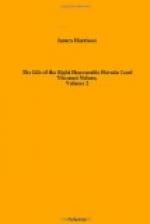Lord Nelson, in the mean time, having weighed; at eight in the evening, the fleet stood to the southward: and, at eight in the morning of the 6th of June, they saw Tobago. At two in the afternoon, abreast of Man of War Bay, Le Curieux joined; with information that an American had arrived at Scarborough the preceding day, the master of which said that he had been boarded, three days prior to his arrival, by the French fleet, then standing to the southward, and that they would, he supposed, pass Tobago as last night. This account, his lordship considered as a mere fabrication of the American: but, gaining no intelligence on which he could rely, he bore away to Trinidada; and, at midnight, bringing to off that island, sent the Pheasant to Toko for information. At four, next morning, his lordship bore up for the Bogasses; and, at sunset, anchored in the Gulf of Paria, but found that the enemy had not been heard of in the island. At day-light, an advice-boat brought letters from Captain Morrice at Barbadoes, giving an account of the capture of the Diamond Rock, with the little garrison by which it was defended: and stating, also, that the French and Spanish squadrons had not sailed from Martinico; but that, as the French commodore told him, the Ferrol squadron, of six sail of French, and eight of Spanish, arrived in Fort Royal on the 4th of June. This intelligence determined his lordship: who, at seven o’clock, sailed from Trinidada; and was at noon well out, clear of the Bogasses.
While his lordship was off Trinidad, with his usual gaiety and goodness of heart, he wrote to the governor, that he would rather he sent him a hogshead of limes, than a hogshead of Joes. With him, the health of his people was always the first object; his own individual wealth, ever the last.
At six in the morning of the 9th, he got within sight of Grenada; and, at noon, arrived off St. George’s Bay in that island. A letter from General Prevost now informed his lordship, that the combined squadron had passed Dominica on the 6th of June; and, having gone to Guadaloupe, for the purpose of landing the troops and stores taken from thence, had been seen standing to the northward. Lord Nelson, on receiving this intelligence, having dispatched the Nelly to Antigua, and the Jason to Montserrat, for farther information, immediately stood to the northward, under a press of sail. The next day, at noon, between St. Lucia and Martinique, he sent a schooner to General Prevost: and, at eight the following morning, Tuesday, June 11, saw Guadaloupe; and spoke an American, from Boston, who gave no intelligence. At noon, the fleet got within sight of Montserrat; and, at two o’clock, saw the Jason, at anchor. The news from Montserrat was, that they had, on Saturday morning, the 8th, being only three days before, seen sixteen sail under Guadaloupe, beating to windward. His lordship, now, also beating up to windward, all night and the following day, anchored in St. John’s




